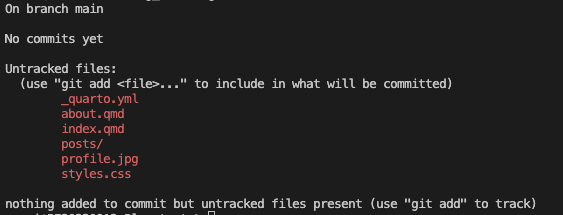Publish your blog
To publish your blog we need to first start tracking it with git:
Tracking your blog with git
In the terminal, make sure you are in the directory of your blog, then type:
git initThis will initialize your blog directory as a git repository.
Initialized empty Git repository in path/to/directory
Now, if you check with
git statusyou will see that the repository is indeed empty. You will also see some untracked files.

Add all the files to the repository and commit the changes to git.
add the blog to GitHub
Now we need to add the local repository to GitHub. Log into GitHub on the homepage. Then add a new repository, give it a name and make it public. Do not add anything to it, not .gitignore, README, license etc.
Once initialized, GitHub will give you several suggestions of what to do with your new repository. Follow the instructions of the option: ...or push an existing repository from the command line
Back in VScode, check in the terminal that you are in the correct directory (the one of your blog).
You can then add the remote origin etc with the commands given on GitHub:
git remote add origin <specifics of your repository>
git branch -M main
git push -u origin mainCheck on Github if the content of your blog has been added. You might have to refresh your page.
publish via GitHub actions
Now that you have a local git repository that is synced to GitHub you can publish your blog using GitHub Pages, a website hosting service.
The default URL of your blog will be a combination of your GitHub user name and the name of the repository. If you have your own domain you can also use that at a later point in time.
The steps for publishing your blog with GitHub Actions are here. Follow the instructions until the section Executing code.
Now, the publish command will be triggered automatically every time you push changes to the remote repository.
Tips and tricks
When working on the blog, use git (adding, committing, pushing) often. Try to keep commits to one topic - maybe one blog entry per time. This way it is easier to label the commits and backtrack what has happened in the repository.
Do not add large files to the repository. GitHub is a code hosting platform, not a data hosting platform. If you have data in your local directory you can exlude it from the repository with the .gitignore file.
